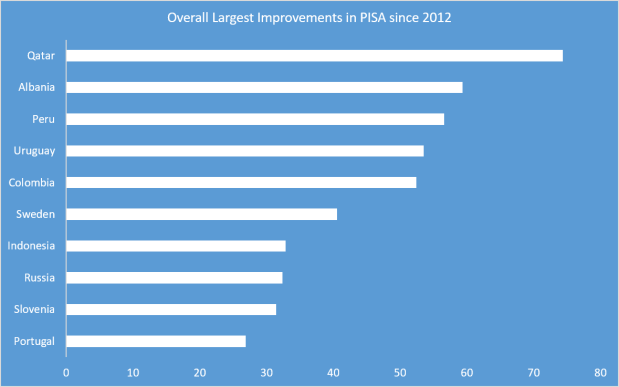PISA Results: Which Countries Improved Most? Today, the Organisation for Economic Co-operation and Development (OECD) released results from the Programme for International Student Assessment (PISA). PISA is a triennial international survey which aims to evaluate education systems worldwide by testing the skills and knowledge of 15-year-old students. In 2015, over half a million students in 72 countries and economies were assessed in science, mathematics and reading…

Copying Singapore’s Math Homework The world needs a network of organizations to help countries learn from each other’s education systems. Every three years, hundreds of thousands of teenagers in dozens of countries take…
Henry Levin: Take PISA Test Results “With Grain of Salt” The results of the Program for International Student Assessment (PISA) test of 2015, due out next week, “represent a massive evaluation of schools and student achievement across the world,” writes Henry M. Levin, TC’s William H. Kilpatrick Professor of Economics and Education, on the Best Countries pages of the US News & World Report website, published on Nov. 30…
It must be the chopsticks: The Less Reported Findings of 2015 TIMSS… TIMSS (Trends in International Mathematics and Science Study) beat PISA by one week. It just released its 2015 results. Within hours of the release, Google News has already collected over 10,000 news stories reacting to the results from around the world, some sad, some happy, some envious, and some confused. The biggest news is, however, nothing new: Children in East Asian countries best at maths. They were the best 20 years ago when TIMSS was first introduced in 1995. They were the best in all subsequent cycles…
Stop Copying Others: TIMSS Lessons for America TIMSS has become one of the two most influential international testing programs in the world today, the other being PISA. First introduced in 1995, TIMSS is conducted every four years to assess math and science learning in fourth and eighth grade. It has had significant impact on math and science education in the world over the last 20 years. Its impact on the U.S. education policies and practices over the last two decades cannot be overstated…
Education’s hollow promise of social mobility in Europe As 2016 draws to a close, few questions are asked with greater urgency in Europe than this: How can countries tackle inequality? Education usually tops the list of most promising solutions to inequality between rich and poor or between advanced and lagging regions. Education equips children and youth, regardless of their social background, with the skills to get a good job. As such, it is an engine of social mobility. So goes the theory. But what about the practice?…
When Schools Fail: Taking Radical Steps To Improve Education Recognising the stark and growing educational achievement gap between rich and poor, governments and policy makers around the world are experimenting with innovative schooling models that aim to bring together the best of the public and private sectors in charter school or academy frameworks. The government of the Western Cape recently launched collaboration schools, a bold new experiment aiming to give learners in some of South Africa’s most dysfunctional schools a great education and better chances in life. Collaboration schools draws on lessons learned from elsewhere in the world, adapted to the unique context in South Africa…
A need for speed: evaluating innovations rigorously in real-time Evidence about what actually works in improving education outcomes is lacking, as noted in a recent 3ie systematic review. We know a lot about what works in some countries, in specific contexts, some of the time, but we don’t know a lot about what works most of the time in any country, regardless of context…
China: Xi calls for stricter ideological control of universities China’s President Xi Jinping has called for the country’s universities to become ideological “strongholds” of the Communist Party, the latest move in a crackdown on academic freedom…
